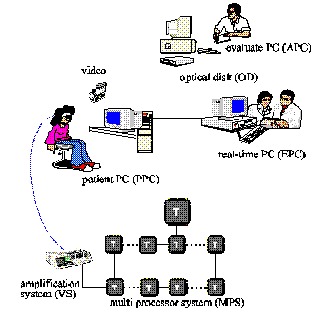G. Roscher
ICS Dr. G. Roscher GmbH, Magdeburg-Barleben, Germany
Current EEG analysis is limited to recognition of electrical phenomena in the brain in batch processing after acquisition without understanding its significance (F. Crick). The question yet to be answered is: Are the "atoms of thought" coded in the EEG (D. Lehmann)?
The new strategy of computer aided analysis of the EEG in real-time uses the high performance of human intelligence for subjective interpretation of behaviour and for pattern recognition in conjunction with quantitative computer analyses and psychological tests. With this new strategy we make a small step forward to understanding the significance of identified phenomena in the EEG.
The EEG system developed consists of a special amplifier system for high-quality signal detection in open field conditions during communicative situations. New information technology has also been developed which is capable of processing the huge amounts of data produced by a multi-channel EEG record to gain information in real-time. The network of two or more PCs is coordinated through a high-tech multi-processor system for real-time analyses and recognition of EEG-activity. Multimedia approaches to the application of psychological tests are possible through the user interface including tests in media of sound, pictures, moving pictures and words. These tests can be arranged and carried out in computer controlled sequences and modified by user interactions. Tools are also provided to allow the user to create his own tests.
The new and patented method is based on information theory and describes the EEG activity as sequences of so called virtual sources in parameters of amplitude, time and space. Fuzzy logic and methods of AI are used to define and recognise sequences of virtual sources in real-time. This method is integrated into the powerful graphical user interface and uses a database system. Incorporated into this user interface are the state of the art EEGSYS algorithms from the NIMH (Washington, USA) for mappings, FFT, etc.

The figure demonstrates the impacts and applications of the new strategy for EEG investigation in communicative situations between:
With a better understanding of EEG activity we can begin to understand the link between psychological disorders and physical illnesses and therefore create more effective diagnostic and corrective therapeutic strategies.